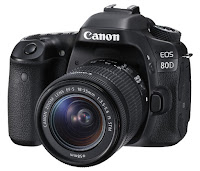The new 24.2 megapixel CMOS sensor with DIGIC 6 processor provides excellent clarity and the freedom to crop in, while the new 45 all cross-type point AF system and 7fps shooting can capture action with precision. For pin-point focusing or wide-area tracking, the AF points are individually selectable or grouped into areas, giving you greater control over composition regardless of where your subject is in the frame. When using lens combinations with narrow apertures, 27 f8-compatible AF points offer focus, in even the most extreme situations.
Designed to shoot in varying light conditions, the camera has a native ISO 100-16,000 range, expandable to ISO 25,600, and the AF system will continue to work even under moonlight (-3EV). The 7560-pixel RGB+IR metering sensor measures both visible light and invisible infrared radiation for accurate exposures, while Flicker Detection ensures consistent exposure when shooting under flickering artificial lights. A new White Priority setting helps you to reduce the appearance of warmer tones.
A camera that adapts to you
The camera’s design means you can customise your shooting experience, with conveniently-placed controls giving access to the most commonly used modes and settings. The Intelligent Viewfinder displays 100% of the frame, as well as the current settings. You can switch to the 7.7cm (3-inch) Vari-angle Clear View LCD II Touch screen for movie shooting, Live View mode, or accessing functions quickly.
Whether you’re creating a travel vlog or cinematic-style movie, the EOS 80D offers total flexibility with Full HD movie shooting. Achieving accurate autofocus and smooth focus tracking is effortless thanks to Canon’s unique Dual Pixel CMOS AF technology. Both AF speed and AF tracking sensitivity can be adjusted, giving you complete control over the pace and responsiveness of the AF to suit the style of your movie.
Serious videographers can be confident footage will achieve a professional-looking result, with the ability to shoot at 60p in MP4 format – perfect for slowing down the action while still controlling focus. The EOS 80D includes both headphone and microphone inputs, allowing you to capture and have full control over audio during a shoot.
Easily connect, shoot remotely and share your work
Enjoy the freedom of remote shooting via your smartphone or tablet using the EOS 80D with Canon’s Camera Connect app. Built-in Wi-Fi and Dynamic NFC connectivity makes it simple to connect with and share full resolution JPEGs to your smart device. You can also connect to and control your camera via a PC, without the need for a home Wi-Fi router, and quickly save, view and share your photos and movies all from one single accessible location using Canon’s Connect Station CS100.
Pricing and availability
The EOS 80D is available from April 2016 with an RRP of £999.99/€1399.99 body only.
>> More details and full specification
